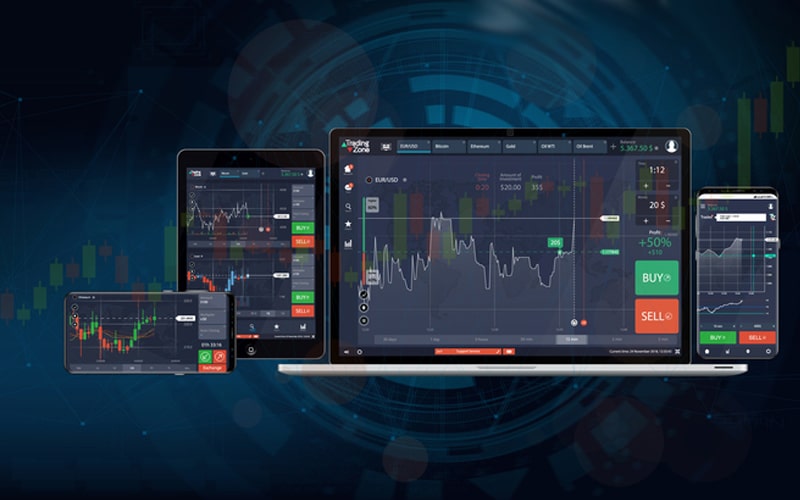Overview
In life, we all use some form of leverage to gain some competitive advantage or make our lives easier with minimal resources. The concept is pretty similar in the realm of crypto trading; leverage is about making a lot with a little.
With enough skill and risk management, high leverage can yield a trader substantial profits. Although crypto trading platforms are a dime a dozen, not all of them offer this tool. Therefore, this guide will focus on the alternatives by outlining their main features and pros/cons.
What is leverage in crypto trading?
Leverage (sometimes referred to as margin) is a tool used in virtually all derivatives trading, allowing you to trade far larger amounts than your account would normally. We express leverage according to ratios like 1:10 or 10x, reflecting how many times your initial account balance is multiplied.
For a better illustration, let’s go over a simple example. Imagine a trader had $1000 in their account but wished to execute a position on Bitcoin (BTC) worth $10 000. If one had 1:10 or 10x leverage, they could open this trade as if they had $10 000 in their account.
However, it’s a widely-known adage that leverage is a double-edged sword, meaning it can magnify profits and losses equally. Therefore, if the trader gained $200 from the price going up in our previous example, their $1000 balance could be in a $200 loss as well.
The highest leverage for spot trading in crypto generally is not above 1:100. With futures, this is not above 1:200 at present.
These ratios are far lower than forex, but this doesn’t mean using leverage is less risky. Leverage is technically a form of collateral as you are using borrowed capital from an exchange or broker to execute trades, meaning some interest is charged.
This is referred to as a rollover or swap, as the interest applies when you ‘roll over’ or maintain your position over a certain number of hours (usually four), charged as a percentage. In our last example, if the rollover were 0.01% every four hours, you’d be charged $1 ($10 000 [the value of the position] X 0.01%/100) every four hours or $6 daily.
Pros and cons of leverage in crypto trading
Of course, the most appealing quality of high leverage crypto trading is the ability to gain substantially higher profits with relatively little money. In this case, you don’t need massive capital to trade as you would with less-leveraged financial instruments like equities.
High leverage opens up the playing field for those with limited funds to benefit from the high volatility of the crypto markets. Also, crypto margin trading allows for better diversification (due to the amplified buying or selling power) since you can open more positions across other pairs.
However, the most significant downside is high leverage can lead to magnified, irrecoverable losses. Therefore, you should use this tool with discipline and preferably have some prior experience with derivatives trading to reduce mistakes.
Factors to consider when choosing crypto trading platforms with high leverage
Here are the main things to consider when choosing a high-leverage crypto trading platform.
Security
This factor is of particular significance, considering that cryptocurrencies are decentralized. Thus, any crypto margin trading platform should adhere to the highest security practices.
These include cold storage of client assets, data encryption, two-factor authentication, and identity verification (unless you prefer to trade anonymously).
Yet, traders should take full responsibility on their side by understanding the practices they should follow, particularly as it pertains to storing their funds in wallets and transacting. You may also prefer using licensed or regulated institutions. However, it’s worth noting that many crypto trading platforms are technically unregulated.
Trading costs
Like any financial market, high leverage trading in crypto comes with fees. Exchanges or brokers typically levy maker-taker costs (or spreads/commissions per trade), deposit/withdrawal charges, and rollover. Overall, you’ll want the lowest possible in all of these.
Moreover, you should observe whether you can start trading with any amount or whether there’s a fixed minimum.
Payment methods
Nowadays, crypto trading platforms accommodate as many clients globally by providing numerous ways to fund and withdraw from their accounts.
This includes crypto-to-crypto, fiat-to-crypto, and other options like bank wire, debit/credit cards, and digital wallet services like PayPal. Regardless of your preferred method, you should always ensure it’s not costly.
Range of markets offered
High crypto margin trading is only effective when you can use it across a wide range of markets. Therefore, you should stick with platforms providing the broadest selection of tradable coins.
One should also note that derivatives trading has gone beyond spot trading (the most basic type). Experienced speculators can now access other interesting markets like futures, perpetuals, and options.
Wallet provision
Ideally, you’ll want a crypto trading platform to have its own in-built wallet for you to store your tokens. Some companies are only exchange facilities and, thus, cannot provide this facility. Therefore, if the platform does have a wallet, it prevents the user from having to find an external service, making it more convenient.
Customer support
If you’re using any financial services provider, you’re bound to run into problems, necessitating the need for a responsive and functioning customer support department. The channels which should be included are live chat, phone, and email support tickets.
Live chat is especially crucial because it’s the most accessible and simplest way to solve most queries. Some exchanges or brokers may not have a live chat and/or phone, making their customer support less user-friendly. These are some of the things to note in this regard.
Top 5 trading platforms with high leverage
Let’s now explore the five best high-leverage crypto trading platforms by exploring their main features, a brief overview, and the pros/cons.
Binance
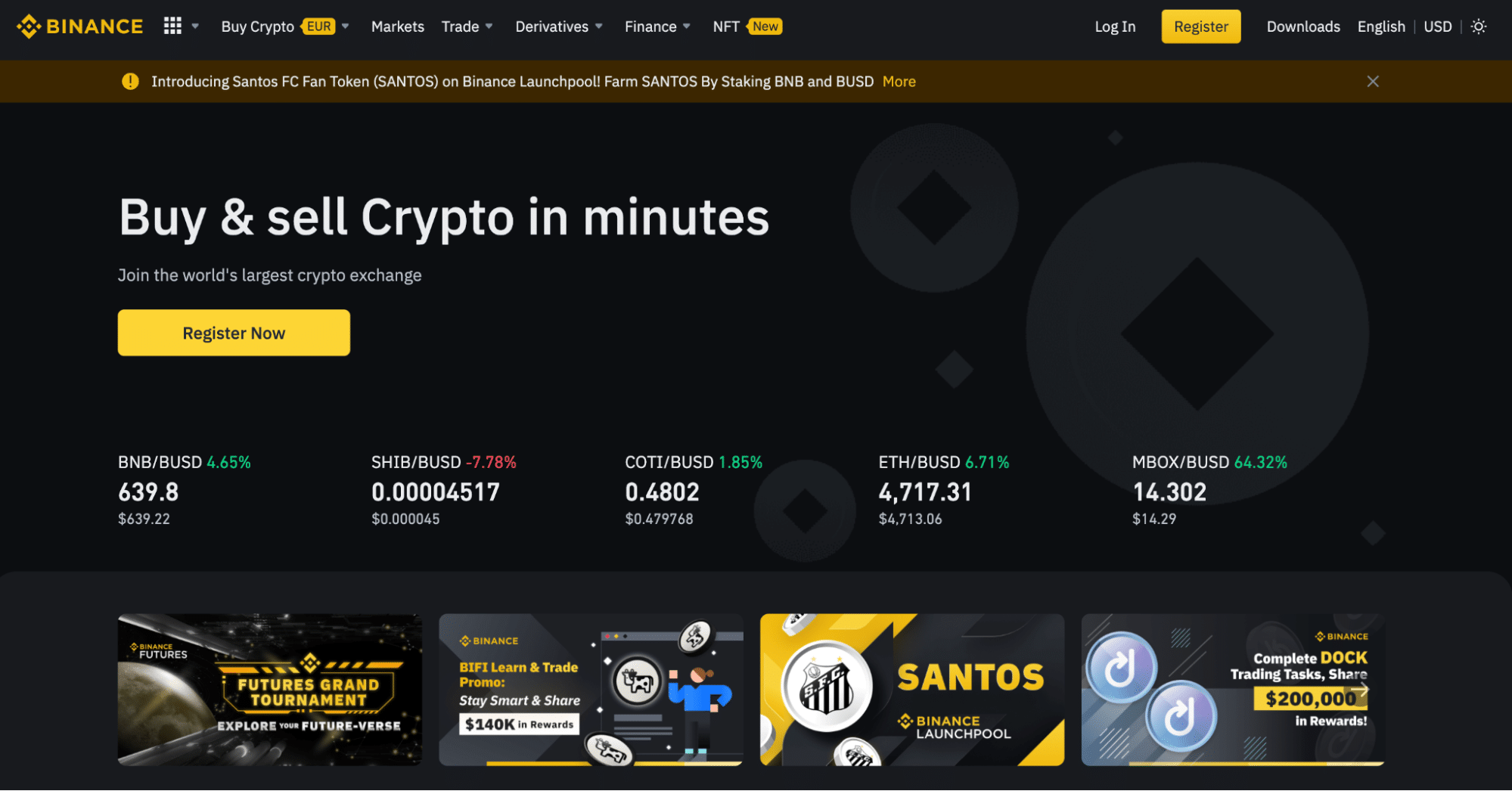
Features
- +1500 crypto markets
- Reasonable starting balance on all markets
- Maximum of 0.1000% maker / 0.1000% taker fees
- No deposit fees
- Offers spot (up to 10x leverage), perpetual swaps/futures (up to 125x leverage), leveraged tokens (up to 4x leverage), and options
- Supports over 40 fiat currencies for funding
- Deposits/withdrawals are available via crypto, bank transfer, debit/credit card, ATMs, and other options like Banxa, Simplex, and PayPal
- Utility token (BNB) offers numerous perks
- Built-in wallet
- Email and live chat support
Established in 2017, Binance remains the largest exchange by trading volume. Hence, it’s a popular platform for high-margin trading in cryptocurrencies. Binance has some of the lowest trading fees, a comprehensive selection of tradable cryptocurrencies, and numerous kinds of derivatives.
By holding BNB (Binance’s utility token), traders get up to 25% off on spot trading and 10% on futures trading fees. These are some of the features making Binance a no-brainer in high leverage crypto trading or trading overall.
Advantages
- Largest crypto trading platform by volume
- Competitive trading costs
- Has some of the broadest selection of tradable markets
- Offers different types of derivatives
- Has utility token providing trading fee discounts
- Built-in wallet
- Many payment methods are available
Disadvantages
- No phone support
FTX
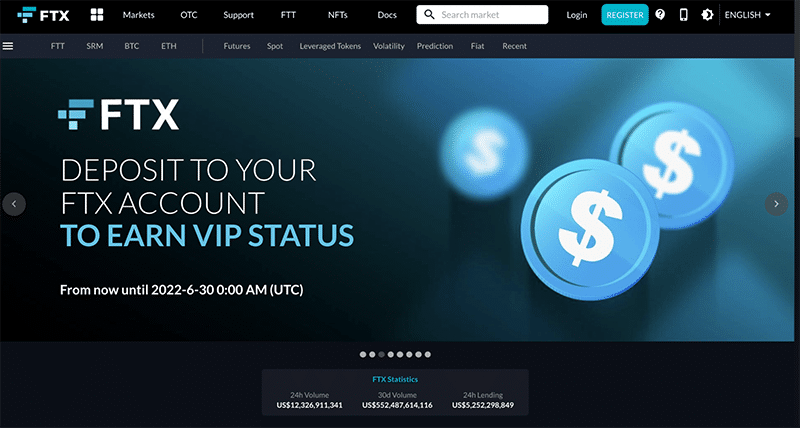
Features
- Regulated by the Securities Commission of the Bahamas
- +400 crypto markets
- No minimum deposit
- No deposit fees
- No withdrawal costs for most coins
- 0%-0.02% maker fees / 0.04%-0.07% taker fees
- Leveraged spot, futures (1:20 max. leverage), ERC20 tokens (1:3 max. leverage), options, volatility, and prediction markets provided
- Supports 8 fiat currencies
- Deposits/withdrawals available via crypto, bank transfer, debit/credit card, ACH
- Utility token (FTT) provides many benefits
- Built-in wallet
- Email customer service
FTX is another prominent crypto trading platform launched in May 2019, founded by a team with quant trading experience from Wall Street firms. FTX excels in having a vast market selection, several derivatives, and below-average fees.
With FTT, FTX’s utility token, users can receive reduced maker fees and other perks like free daily withdrawals on Ethereum-based tokens and staking rewards. Like Binance, FTX has another exchange dedicated to US customers called FTX.US, where American clients can trade with up to 10x leverage.
Advantages
- One of the largest exchanges globally by trading volume
- Affordable trading fees
- Broad selection of derivatives and markets are available
- Has the FTT utility token
- Supports numerous fiat currencies
Disadvantages
- No live chat or phone support
PrimeBit
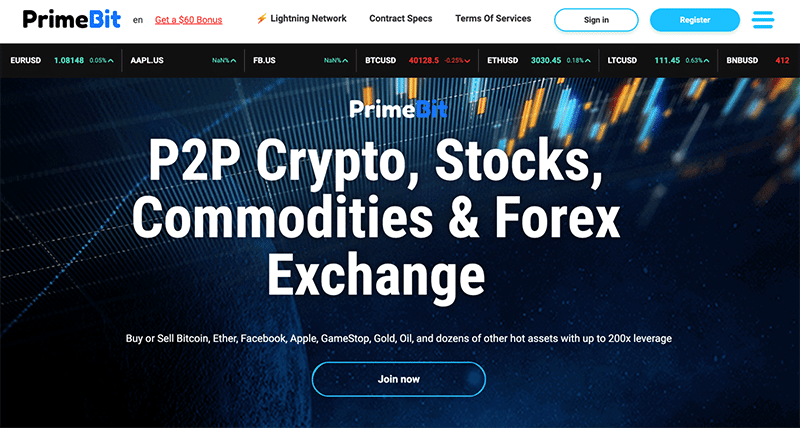
Features
- Anonymous trading (no KYC needed)
- 5 crypto markets are available
- No minimum deposit
- No deposit fees
- 0.02% maker fees / 0.05% taker fees
- Perpetual futures with 1:200 max. leverage
- Deposits/withdrawals only via Bitcoin and Tether
- Built-in wallet
- Email and live chat support
Launched in August 2019, PrimeBit is a relatively new high leverage crypto trading platform based in Saint Vincent and the Grenadines. It provides perpetuals futures across a select-few number of markets in forex, oil, natural gas, stocks, indices, and, of course, digital currencies.
In the latter aspect, traders can get up to 200x maximum leverage on BTCUSDT (Bitcoin/Tether), ETHUSDT (Ethereum/Tether), LTCUSDT (Litecoin/Tether), BNBUSD (Binance Coin), and DOTUSD (Polkadot).
Interestingly, PrimeBit doesn’t follow any KYC (Know Your Customer) process, making it a viable option for those who don’t wish to disclose their personal information.
Even though the platform’s market selection is far lower than the average (among other drawbacks), we’ve included PrimeBit in our list as it probably provides the highest leverage for trading cryptos.
Advantages
- It offers some of the highest leverage
- No KYC required
- Provides a demo account
- In-built wallet
Disadvantages
- Quite a limited market selection
- Restricted payment methods
- Some risks with offshore no-KYC trading platforms
OKX
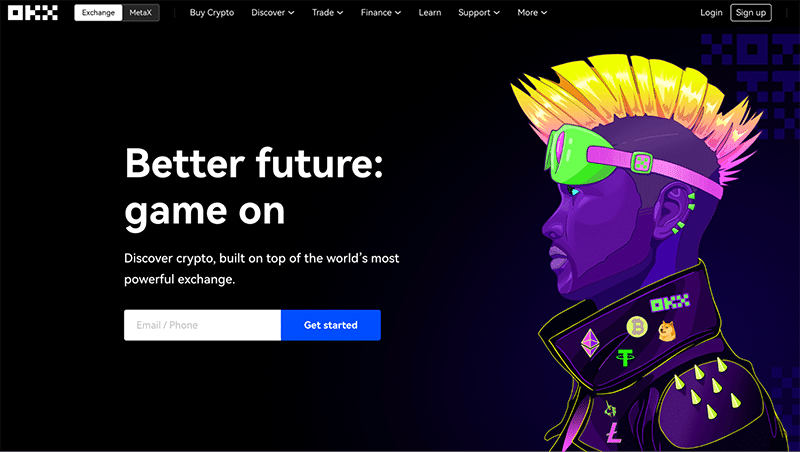
Features
- +300 tradeable cryptocurrencies
- 0.08% maker and 0.10% taker fees
- No account minimum
- Provides leveraged spot (10x max leverage), perpetual swaps, futures (both 125x max leverage), and options trading
- Supports over 30 fiat currencies for payments
- OKB utility token
- Built-in wallet to store coins
- Phone, email, and live chat support
Founded in 2017, OKX is a Seychelles-based crypto trading platform, a sister exchange to the more established OKCoin. It is one of the top derivatives crypto platforms by trading volume.
With OKX, you can speculate in over 300 coins with reasonable maker-taker fees and above-average leverage in futures and perpetuals. Like Binance and FTX, OKX has a utility token (OKB) offering reductions on trading costs and other rewards.
All in all, OKX has confidently positioned itself as the one-stop digital currency exchange providing more facilities than your average crypto trading platform.
Advantages
- One of the largest exchanges by daily trading volume
- A broad range of tradable coins is available
- No minimum trading balance
- Provides numerous trading types
- Different customer support options
- Has utility token (OKB)
Disadvantages
- Complex fee structure
Kraken
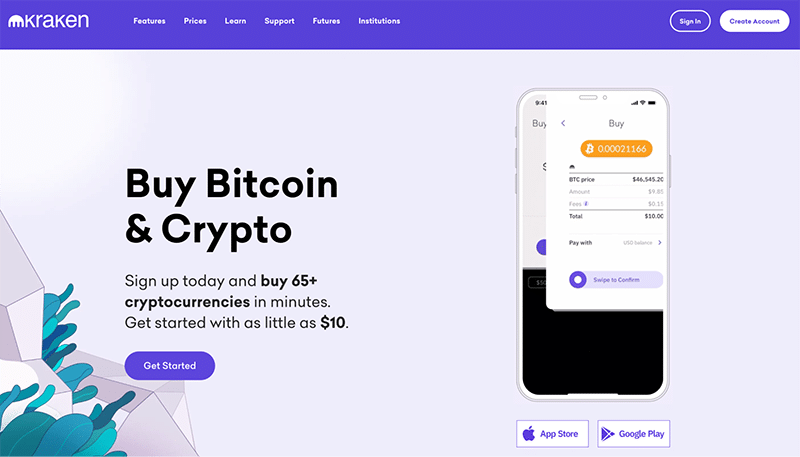
Features
- 145 tradable markets
- Max. 0.16% maker and 0.26% taker fees
- Affordable minimum deposits
- Deposits/withdrawals available via crypto, debit/credit card, ACH, Apple Pay,
- Margin spot (up to 1:5 leverage), and futures trading (up 1:50 leverage)
- 7 fiat currencies supported
- Phone, email, and live chat support
Named after the mythical sea monster, Kraken is a familiar name in cryptocurrency trading. The brand is one of the oldest in its sector, having been founded in 2011. Kraken is a regulated US-based exchange and hence, unlike many other platforms, accepts clients from the States.
Moreover, everyone can use leverage, which is up to 5x on spot and up to 50x on futures trading. Kraken boasts features like a sizable market selection and decent margin, making it a competitive choice, particularly for US clients.
Advantages
- Been in operation since 2011
- Available for US clients
- Flexible number of payment options offered
- Decent-sized selection of crypto markets is available
Disadvantages
- No wallet provided
- Slightly higher maker-taker fees
FAQs about the top high leverage crypto trading platforms
What US crypto exchanges allow leverage?
FTX.US, Coinbase Pro, and Kraken are some of the few US-based crypto exchanges providing leverage based on our research.
Does leverage affect profit?
Indeed. The more leveraged you are, the higher the potential profit. Conversely, the possible loss is greater if the markets don’t move in your favor.
What leverage is good for beginners?
In crypto, beginners generally shouldn’t go above 10x leverage. However, you should focus on the monetary amount at risk in every position and less on the leverage ratio.
Can leverage get you in debt?
No, as it’s not a traditional loan. However, misuse of leverage can lead to substantial losses where your account can go to zero.
